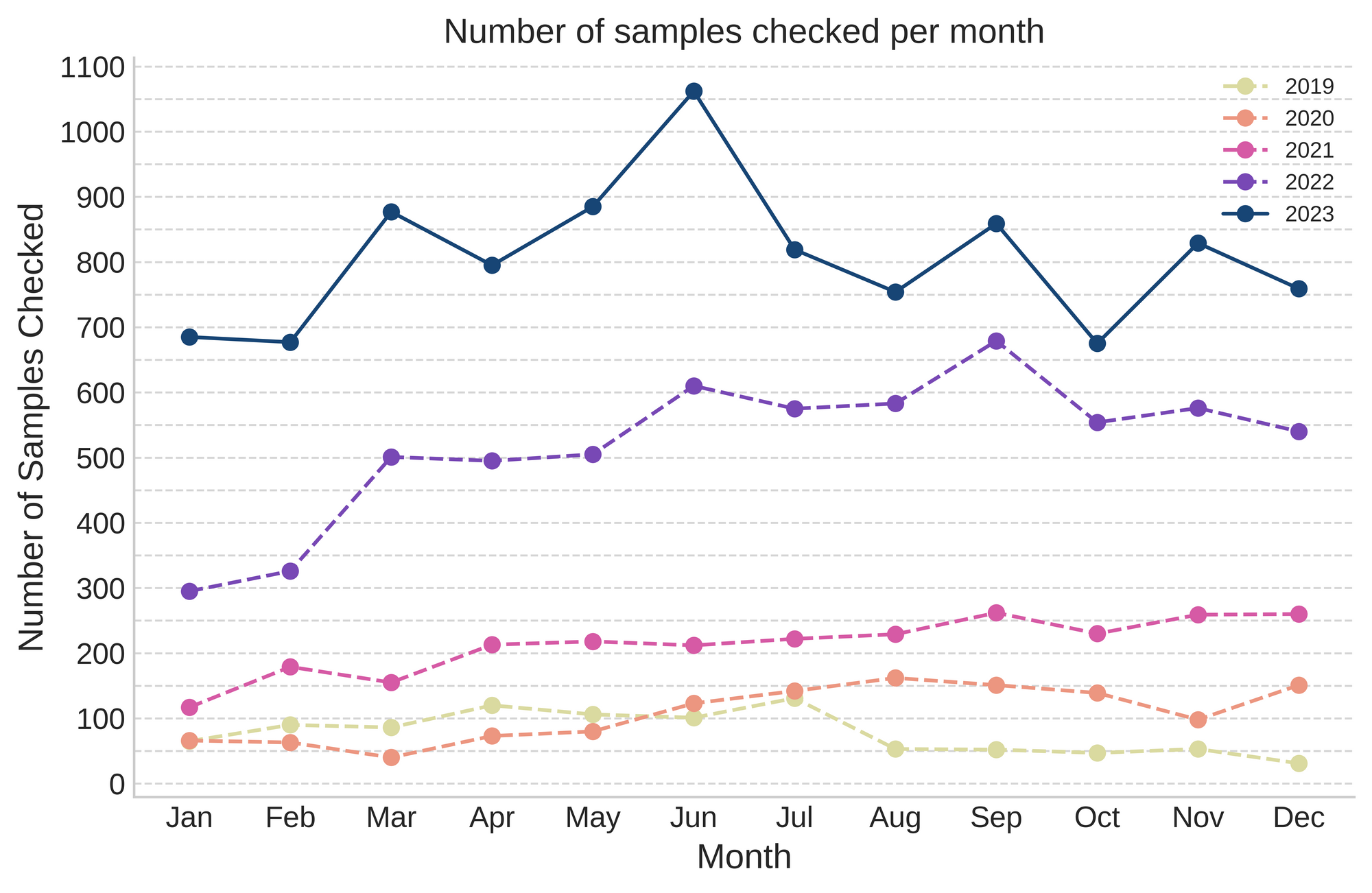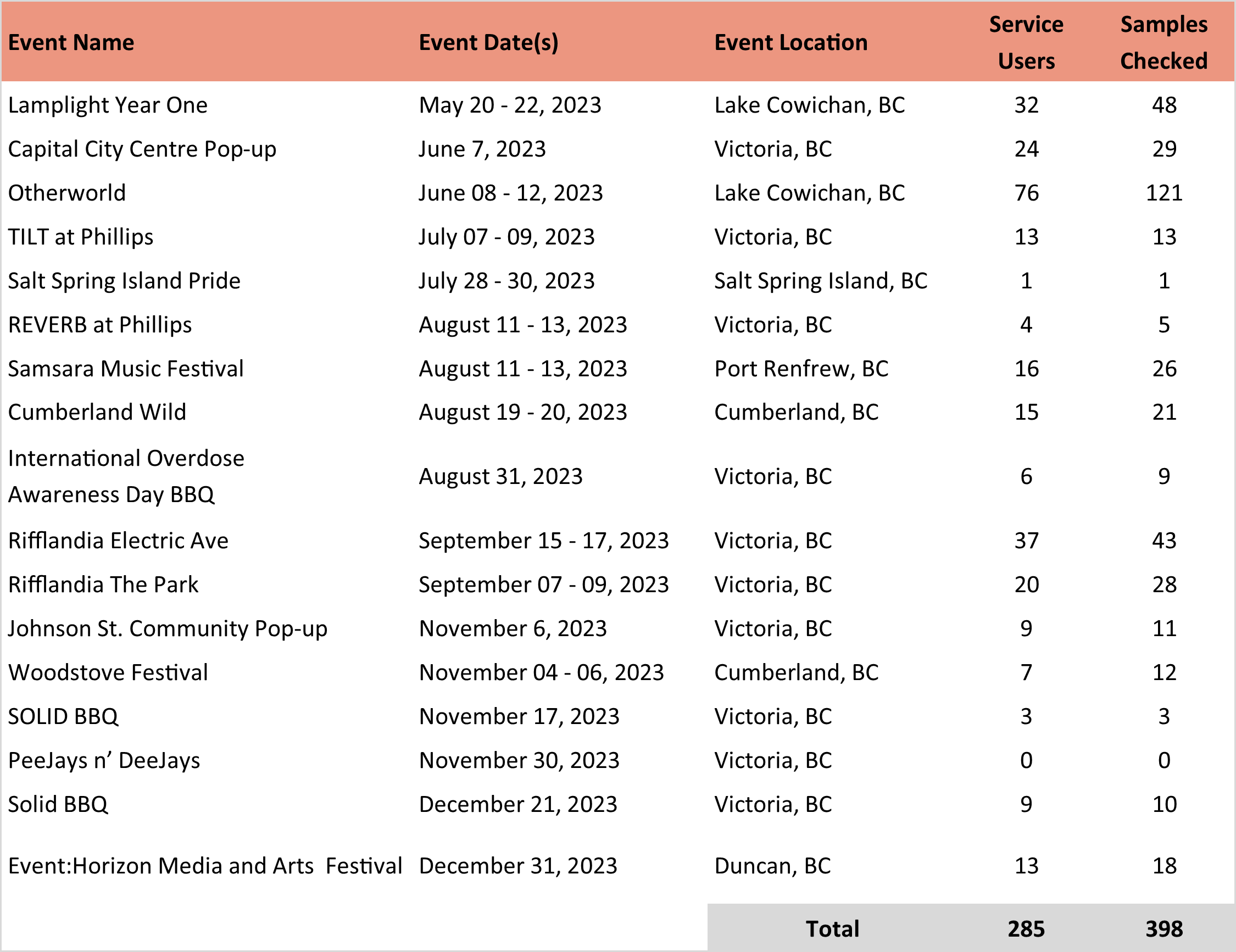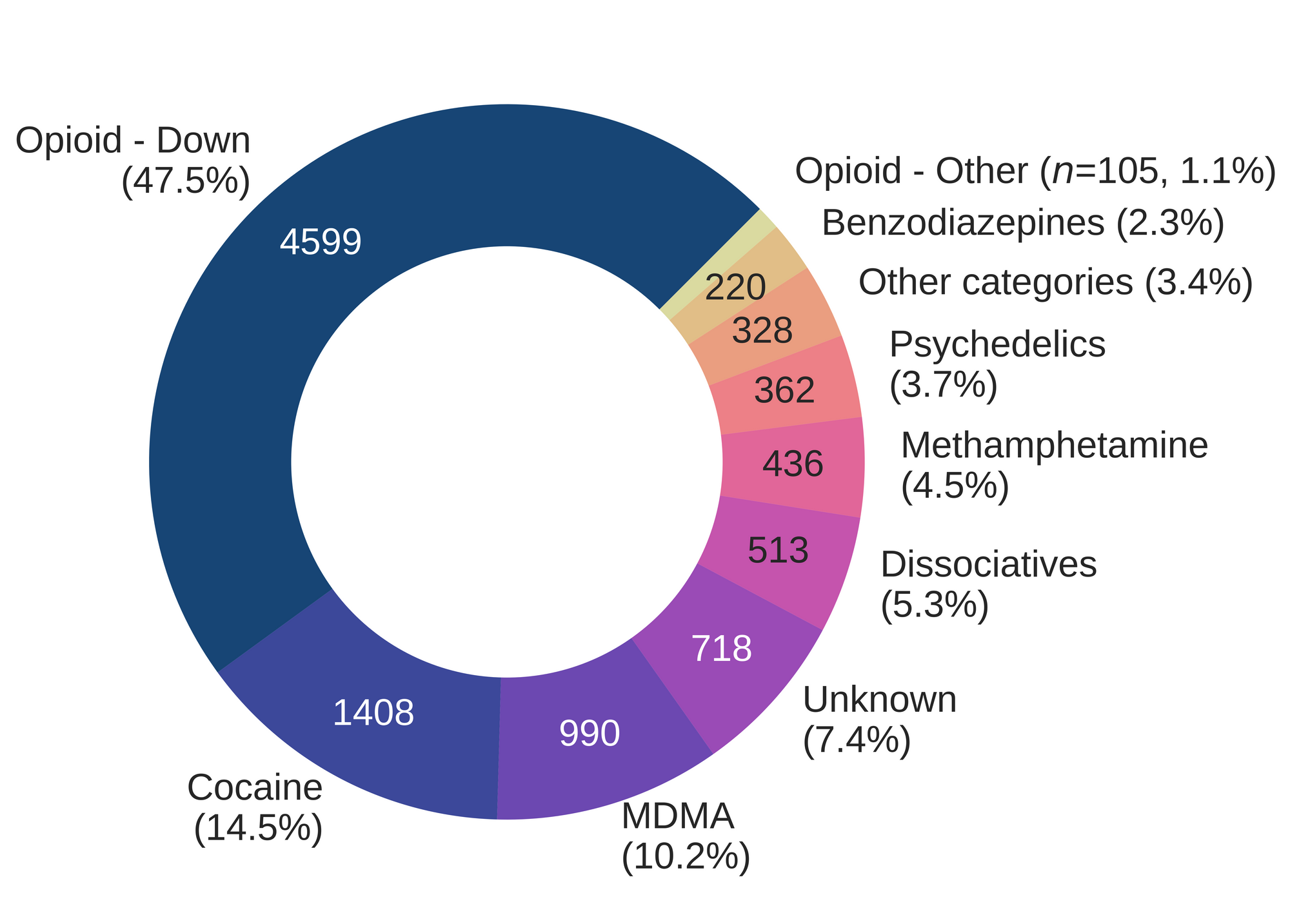2023 Annual Report

Territorial Acknowledgement
Our project works on Indigenous land. We provide drug checking, harm reduction education and support across many territories on what is colonially known as "Vancouver Island." We also act as a resource for these services across the province colonially known as ‘British Columbia.’ We honour and offer respect to many nations for their stewardship, care and leadership on these lands.
Our project originated on the territories of the lək̓ʷəŋən speaking peoples, including the Songhees and Xwsepsum (Esquimalt) Nations, and the W̱SÁNEĆ (Saanich) Nations on whose land the University of Victoria is located. Some of the territories we are honoured to work across specifically include: Halalt, Lyackson, Meluxulh (Malahat), Puneluxutth’, Quw’utsun, Stz-uminus, and Ts’uubaa-asatx; Hupačasath and Tseshaht; K’ómoks; and Laich-kwil-tach.
We acknowledge the inextricable links between research, colonization and racism against Indigenous peoples, which continue to this date. Ending the violence faced by people who use drugs cannot be achieved without actively working on decolonization. We also recognize that as the majority of our staff are not Indigenous there is much more work for us to do to challenge the settler lens and colonial framework. This includes learning and growing relationships in order to take an anti-colonial and inclusive approach to the work we do.
A Year In Review
In 2023, Substance Drug Checking, formerly known as the Vancouver Island Drug Checking Project, continued to provide life-saving information throughout the community of so-called “Victoria”, the larger geographic region of so-called “Vancouver Island”, and within the province of “British Columbia”. 2023 marked 7th year of the overdose crisis fueled by the toxic unregulated drug supply, to which drug checking remains a vital, community-level response.
Our main point-of-care site located within the North Park community of “Victoria” continues to thrive. All walks of life are welcome in this space to learn about their substances via a world-class suite of instruments. We receive samples that arrive by mail and through outreach conducted by Substance staff and partner organizations. We continue to receive samples for confirmatory analysis from our distributed sites on Vancouver Island. Furthermore, we started to receive samples for confirmatory analysis via paper spray mass spectrometry from drug checking sites throughout the province as part of a new pilot project in partnership with British Columbia Centre on Substance Use (BCCSU).
In June of 2023, we checked a record number of samples for any given month–1062 to be exact. As shown in Figure 1, nearly every month in 2023 we checked more samples than any month in 2022, with the exceptions of February and October. Overall, 2023 was our busiest year to date, both at our hub location (also referred to as “Substance”) and at all other sites affiliated with our project.

Distributed Drug Checking and Outreach
This year we continued to provide secondary analysis via paper spray mass spectrometry to our distributed sites located in overdose prevention sites operated by the Port Alberni Shelter Society, the Vancouver Island Mental Health Society in Campbell River, and Lookout Housing and Health Society in the Cowichan Valley, as well as AVI Health and Community Services in the Comox Valley and Campbell River. The continuity of drug checking services in these communities was clearly valued as each of the distributed sites more than doubled the number of samples they checked in 2023, greatly surpassing the relative increase seen at our hub location.
Overall, our distributed site in Duncan saw the highest increase in samples from 2022 with a whopping 1063.6% increase! Our distributed site in the Comox Valley also saw a fairly hefty increase, with a 462.3% increase in samples from 2022. Campbell River saw a 204.0% increase in samples, which is possibly attributed a second distributed site opening at Campbell River AVI. Last but certainly not least, our distributed site in Port Alberni saw a 106.0% increase in samples checked. The number of samples checked per location and their relative increase from 2022 is shown below in Table 1.

Here in so-called “Victoria” our outreach program collects samples from various housing and supervised consumption sites, including but not limited to the Howard Johnson Hotel (now closed), Tiny town (now closed), Mt. Tolmie (now closed), Soleil, Johnson St. Housing, 900 block Pandora St., The Harbour supervised consumption site, The Juniper, Tally Ho, Queens Manor, AVI Victoria, and Capital City Centre. In 2023 this program saw a 116.0% increase in samples compared to 2022.
While one goal of the outreach program is to help more people access drug checking, another goal is to create and nurture connections with community members and staff from other organizations. One way we maintain these connections is by sharing information about the local drug supply through our weekly and monthly reports, in addition to other resources made or maintained by Substance such as drug pamphlets and benzo equivalency charts. Overall, our outreach program has grown tremendously in 2023, part of which can also be attributed to the success of our event and festival drug checking program.
Festival and Event Drug Checking

We were able to utilize the BC Ministry of Health’s authorization to operate Urgent Public Health Need Sites (UPHNS) in order to provide pop-up drug checking at various events, festivals, and housing sites across Vancouver Island during 2023. In total, we operated 17 pop-up drug checking services in 2023, these services reached a total of 285 service users and provided valuable, potentially life saving information about the composition of 398 samples. When compared with the 2022 event drug checking data, this represents a 111.1% increase in service users reached and a 109.5% increase in samples checked.
Overall, the three busiest events were Otherworld, which had the highest volume of samples at 121 (nearly double number of sample checked at Otherworld 2022), followed by Lamplight Year One (48), and Rifflandia Electric Ave (43).
What were people bringing to get checked?
Service users bring us a wide variety of substances that can be grouped into different drug classes. The donut chart below (Figure 2) aggregates the total number of samples we checked by their expected substance (i.e. the drug category reported by the service user), inclusive of all service locations. The consistent access of multiple drug categories through the entire year and across the island demonstrates the continued need for both universal and population-targeted approaches to drug checking services and the accessibility of services.

Some example[1] drugs within each class are as follows: Opioid - Down: fentanyl, fluorofentanyl, other fentanyl analogues, heroin. Cocaine: cocaine HCl (powder/soft), cocaine base (crack/hard/rock). MDMA: MDMA, MDA. Dissociative: ketamine, novel dissociatives like DMXE. Benzodiazepines: alprazolam (Xanax), bromazolam, diazepam (Valium), etizolam. Psychedelics: 2C-B, DMT, LSD. Opioid - Other: hydromorphone (Dilaudid), oxycodone. Other categories: 3-MMC, Adderall, methylphenidate (Ritalin), GHB, quaaludes, cannabis products, steroids, novel “designer drugs.” Unknown: samples where the expected drug was not known by the service user.
This list is not comprehensive to every expected drug within each subcategory ↩︎
Full Report
If you'd like a full breakdown of what we found in each category of drugs, including the prevalence of active components and cutting agents, and quantification data please check out the full report which you can find below.
